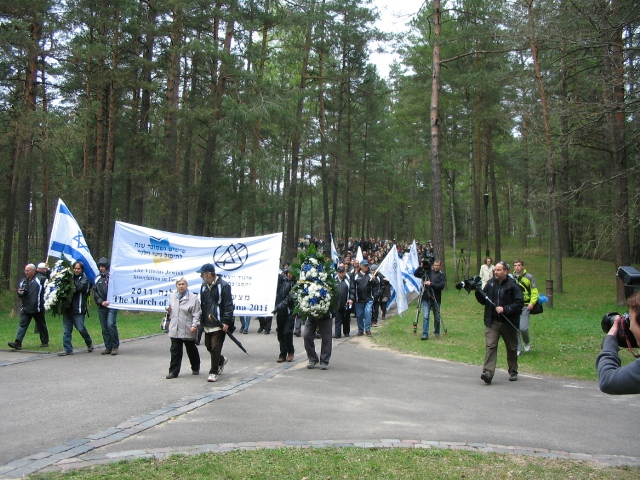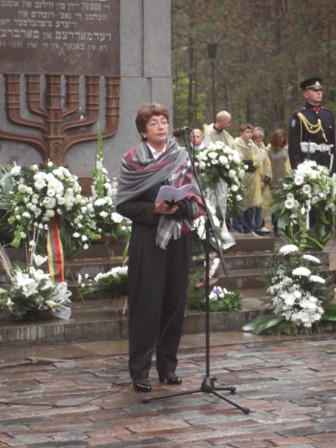Despite efforts by officials to suppress the photographs of the July 2011 desecration at the Ponár (Paneriai) mass murder site outside Vilnius, a cellphone image was released today to DefendingHistory.com by a former employee of the Tolerance Center who reported that he felt obliged by conscience to release the image. The Tolerance Center is the headquarters of the state Jewish museum which in addition to three addresses in Vilnius, runs the small museum at the Ponár site, where the desecration took place. This is the image of the paint attack on the main monument:
Ponár (Ponary, Paneriai)
First Full Photo of July 2011 Ponár Desecration
Ponár Desecrated: Authorities Try to Cover Up the Event; No Arrests, No Reaction from Officials
This page has moved. The new URL is
Authorities Cover Up Desecration of Lithuania’s Largest Holocaust Mass-Murder Site
or click here. Thank you.
Milan Chersonski on the ‘March of the Living’ at Ponar
O P I N I O N
by Milan Chersonski
МАРШ ЖИВЫХ. ВПЕЧАТЛЕНИЯ И РАЗМЫШЛЕНИЯ
В календаре памятных дат Государства Израиль есть День памяти Жертв нацизма и Героев сопротивления – Йом а-Шоа вэ а-Гвура. По европейскому календарю он приходится на 19 апреля – день начала восстания в Варшавском гетто в 1943г.. Почти месяц – дольше, чем польская армия, защищавшая страну от нацистов в 1939г., – истощенные голодом и болезнями, плохо вооруженные узники сражались против специально обученных нацистских формирований и их местных нацистских пособников.

Eyewitness Report: ‘March of the Living’ at Ponar Killing Site near the Lithuanian Capital
E Y E W I T N E S S R E P O R T / O P I N I O N
by Geoff Vasil
I attended the March of the Living today at Ponár (Polish Ponary, Lithuanian Paneriai), the mass killing site outside Vilnius, Lithuania. It is Yom Hashoah, or Holocaust Remembrance Day. I had been to Ponár only once before, because a friend of mine was afraid she would get lost taking the city buses there and back.
Obfuscationists planning Vilnius Holocaust Museum miles away from the City Center
Rumors are flying in the Lithuanian capital about plans to induce foreign institutions and governments to support the building of a new Holocaust Museum at the mass-murder site Ponár (Paneriai), where no unsuspecting tourist or visitor to Vilnius would ever see it, more than six miles out of town, unless they have prior special interest that would motivate the hiring of a taxi for that purpose.
Revolving Posters at Ponár
Ponár (Polish Ponary, Lithuanian Paneriai) is the mass murder site outside Vilnius where around a hundred thousand civilians were murdered by the Nazi regime. Some 70,000 of them were the Jews of Vilna and its region.
Revolving Posters at Ponar?
Ponár (Polish Ponary, Lithuanian Paneriai) is the mass murder site outside Vilnius where around a hundred thousand civilians were murdered by the Nazi regime. Some 70,000 of them were the Jews of Vilna and its region.
Before the war the site was known as a bucolic holiday and picnic spot set in the forest. During the year-long Soviet rule in 1940-1941, large pits were dug for an oil storage facility. After the Nazi invasion the site was converted to a mass murder operation with the ready-dug pits serving as mass graves.
Revolving Posters at Ponár
Ponár (Polish Ponary, Lithuanian Paneriai) is the mass murder site outside Vilnius where around a hundred thousand civilians were murdered by the Nazi regime. Some 70,000 of them were the Jews of Vilna and its region.
Before the war the site was known as a bucolic holiday and picnic spot set in the forest. During the year-long Soviet rule in 1940-1941, large pits were dug for an oil storage facility. After the Nazi invasion the site was converted to a mass murder operation with the ready-dug pits serving as mass graves.
The vast majority of the murderers were local nationalist volunteers organized by the Nazis for the purpose of annihilating the country’s Jewish population. The eyewitness account of Christian Polish journalist Kazimierz Sakowicz was brought out in an academic English edition by Yale University Press in 2005 (Ponary Diary).
The small museum at the site has generally won acclaim for providing authentic information in a very small space and modest means. The primary address in Lithuania for visitors and locals wishing to learn more about the site is the Green House in central Vilnius.
Jewish Community’s Faina Kukliansky gives a Powerful Speech at Ponar Commemoration near Vilnius
This year’s commemoration ceremony at Ponar (Paneriai) was held today, attended by government officials, the diplomatic corps, and a sizable crowd of mostly Jewish participants. Ponar is the mass grave site near Vilnius where 100,000 civilians ― around 70,000 of them Jews of Vilna and its environs ― were murdered by Nazi henchmen between 1941 and 1944. In 2005, Yale University Press brought out Kazimierz Sakowicz’s eyewitness account, Ponary Diary, where it is reconfirmed that most of the killing was done by volunteer local killers.
of Vilna and its environs ― were murdered by Nazi henchmen between 1941 and 1944. In 2005, Yale University Press brought out Kazimierz Sakowicz’s eyewitness account, Ponary Diary, where it is reconfirmed that most of the killing was done by volunteer local killers.
The country’s small but vibrant Jewish community was proudly represented by Faina Kukliansky, head of the Vilnius Jewish Community and vice chairman of the Jewish Community of Lithuania. In her speech (English translation here), Kukliansky, one of the country’s foremost attorneys, did not mince words. She explained that whatever differences of opinion may exist, the community was unanimous in condemning the Double Genocide movement, as well as projects to equate Nazi and Soviet crimes whose purpose is to trivialize or mitigate the Holocaust specifically and the notion genocide more generally. Moreover, she stressed the need to expose the identities of all the local killers who carried out the genocide of Lithuanian Jewry. She also mentioned that it was only the Jewish Community of Lithuania, not the Lithuanian or Israeli government, that established a fund to help each and every Holocaust era Lithuanian rescuer live a better life to the end of his or her days.Continue reading